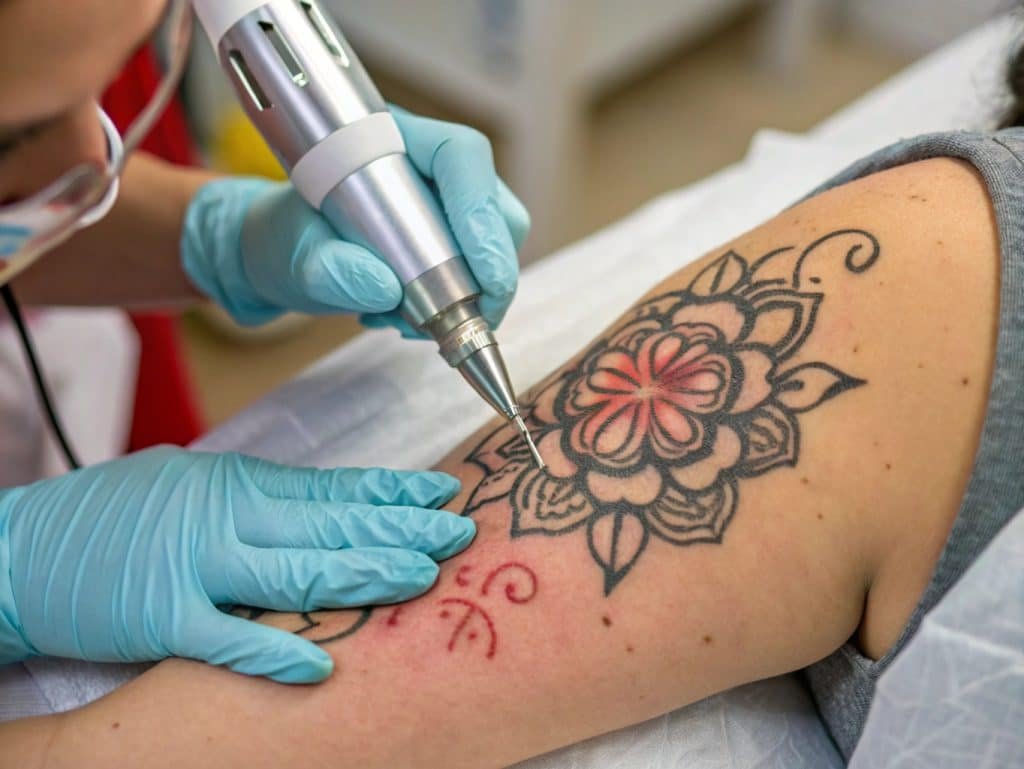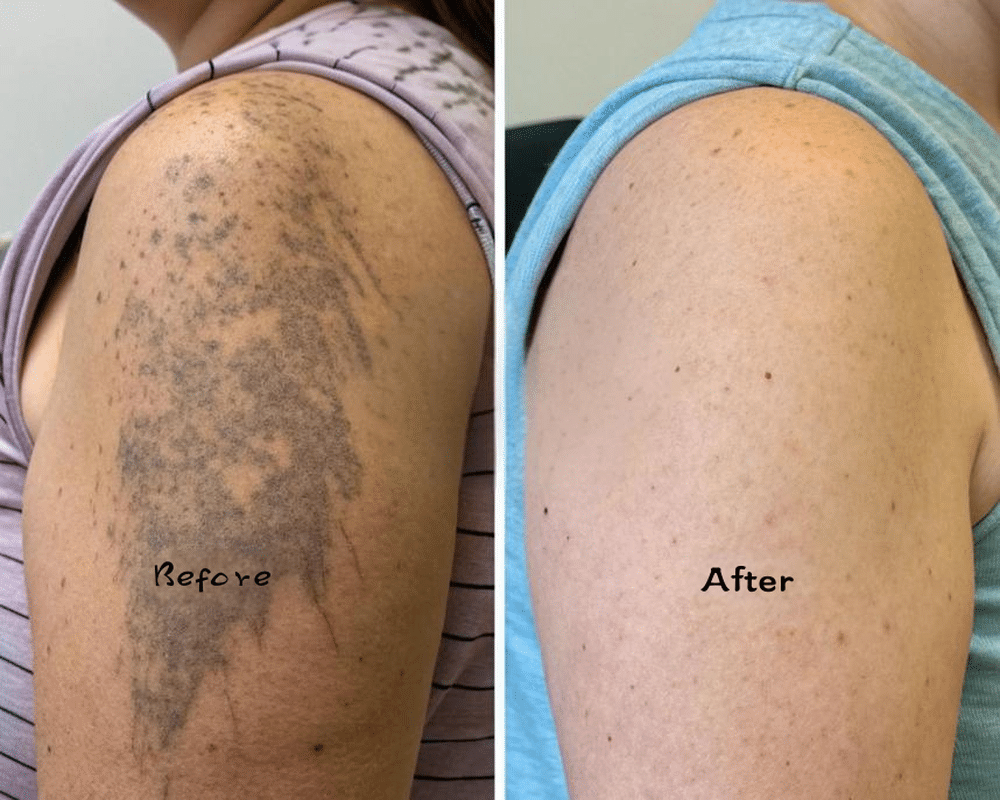Clients want their tattoos removed, but are unsure of the time commitment.They may be hesitant to start a process with an unknown duration.
Laser tattoo removal is a process, not a one-time event. The timeline varies significantly. A personalized consultation is essential for an accurate estimate.

Let's break down the time components.
Understanding the Different Time Components of Laser Tattoo Removal
Clients don't understand the various stages involved.This lack of clarity can lead to frustration and unrealistic expectations.
The overall timeline involves several distinct phases.
Length of Individual Treatment Sessions: How Much Time in the Chair?
- Range: A few minutes to an hour or more.
- Primary Factor: Tattoo size. A small tattoo (coin-sized) might take only minutes, while a large back piece could take an hour or more.
Number of Treatment Sessions Required: A Multi-Step Process?
- Typical Range: 6-12 sessions, or even more for complex tattoos.
- Influencing Factors: Tattoo size, location, ink colors, tattoo age, skin type, and the individual's immune response.
Intervals Between Sessions: Allowing Time for Healing and Ink Clearance?
- Typical Waiting Period: 4-8 weeks.
- Why?: This allows the skin to heal and the body to clear the fragmented ink particles.
Overall Timeframe for Complete Removal (or Significant Fading): Months or Years?
- Realistic Range: 1-2 years, or longer for some cases.
- Emphasis: Individual variation is significant.

It's a marathon, not a sprint. Let's examine the influencing factors.
Factors That Influence the Laser Tattoo Removal Timeline
Clients may not understand why the timeline varies so much.This can lead to unrealistic expectations and disappointment.
Several factors contribute to the overall timeline.
Tattoo Size: A Larger Tattoo Naturally Takes Longer to Remove?
- Yes. Larger tattoos require more laser pulses and more treatment sessions.
Tattoo Location: Does Body Area Affect Treatment Duration?
- Yes. Areas with better circulation and lymphatic drainage (e.g., face, neck) tend to clear ink faster than areas with poorer circulation (e.g., hands, feet).
Ink Colors: Are Some Colors Faster to Remove Than Others?
- Yes. Black ink is the easiest to remove. Darker colors are generally easier. Green, light blue, and yellow can be more challenging and require more sessions. Different wavelengths of light target different pigments.
Tattoo Age and Depth: How Do These Factors Impact the Number of Sessions?
- Older Tattoos: Often fade more easily than newer tattoos.
- Depth: Deeper tattoos (often professional tattoos) require more sessions than shallower tattoos (often amateur tattoos).
Skin Type: Considerations for Different Skin Tones and Healing Rates?
- Fitzpatrick Scale: This scale classifies skin types based on their response to ultraviolet (UV) light.
- Darker Skin: Higher risk of pigmentary changes (hypopigmentation or hyperpigmentation). May require more cautious treatment and longer intervals between sessions.
Immune System Response: The Body's Role in Ink Clearance?
- Crucial Role: The immune system is responsible for clearing the fragmented ink particles. A healthy immune system can contribute to faster clearance.
Type of Laser Used: Picosecond vs. Q-Switched Lasers?
- Picosecond Lasers: Deliver energy in shorter pulses (picoseconds) than traditional Q-switched lasers (nanoseconds).
- Potential Advantage: May shatter ink particles more effectively, potentially leading to faster clearance and fewer sessions. However, this is not always the case, and Q-switched lasers remain effective.
Aftercare Compliance: Following Instructions for Optimal Healing?
- Essential: Proper aftercare promotes healing, minimizes complications, and can contribute to faster overall progress.

Average Timelines for Different Tattoo Types and Scenarios
These are estimates and can vary significantly.
| Tattoo Type/Scenario | Estimated Sessions | Overall Time (Estimate) | Notes |
|---|---|---|---|
| Small, Simple Tattoos | 4-6 | 6-12 months | Typically black ink, small size, good location. |
| Large, Complex Tattoos | 10-15+ | 1.5-3 years or longer | Multiple colors, large size, potentially challenging location. |
| Colorful Tattoos | Varies widely | 1-3+ years | Depends on specific colors; green, light blue, and yellow are often more stubborn. |
| Faded or Older Tattoos | Potentially fewer | Potentially shorter | Ink may already be partially broken down, making it easier to remove. |
| Cover-Up Tattoos | Potentially more | Potentially longer | Increased ink density due to layering. |
| Tattoos on Extremities | Potentially More | Potentially Longer | Poorer blood circulation can slow down the process. |
These are just guidelines. Patience is essential.
The Importance of Patience and Realistic Expectations
Clients may expect immediate results.Disappointment can lead to dissatisfaction and negative reviews.
Laser tattoo removal is a gradual process. Results are not immediate.
Key Points:
- Gradual Fading: Ink fades progressively over time, with each treatment session.
- Realistic Expectations: Set realistic expectations from the outset. Explain that complete removal is not always possible. Significant fading may be the best achievable outcome.
- Communication: Encourage open communication between the technician and the client throughout the process. Address any concerns promptly.
- Some tattoos will not fully be removed.

Patience is key. Let's discuss maximizing efficiency.
Tips for Maximizing Treatment Efficiency and Staying on Schedule
Clients can play an active role in their treatment success.
Aftercare:
| Action | Why? | How to Do It | Potential Complications if Neglected |
|---|---|---|---|
| Cleanse Gently | Removes bacteria and debris, preventing infection. | Use mild soap and water, pat dry. Avoid harsh scrubbing. | Infection, delayed healing, scarring. |
| Moisturize | Keeps the skin hydrated, promoting healing. | Apply a thin layer of recommended ointment (e.g., Aquaphor, Vaseline). | Dryness, cracking, delayed healing, increased risk of infection. |
| Avoid Sun Exposure | Protects the treated area from UV damage, which can cause hyperpigmentation or hypopigmentation. | Cover the area with clothing or use a broad-spectrum sunscreen with SPF 30 or higher. | Hyperpigmentation (darkening), hypopigmentation (lightening), delayed healing, blistering. |
| Don't Pick/Scratch | Allows the skin to heal naturally, preventing scarring. | Resist the urge to pick or scratch, even if it itches. | Scarring, infection, delayed healing, pigment changes. |
| Stay Hydrated | Drinking plenty of water helps with overall healing and bodily processes. | Drink at least 8 glasses of water per day. | Dehydration, slower healing. |
Tips:
- Follow Aftercare: Diligently follow aftercare instructions to promote optimal healing.
- Schedule Regularly: Maintain consistent appointments to stay on track.
- Communicate: Address any concerns with your technician promptly.
- Healthy Lifestyle: Support your immune system with a healthy diet, exercise, and adequate sleep.
- Avoid Sun: Protect the treated area from sun exposure, which can cause pigmentary changes and slow down the process.
Communicating Effectively with Clients About the Treatment Timeline
Miscommunication can lead to unrealistic expectations and client dissatisfaction.Clear and honest communication is crucial for building trust and managing expectations.
Effective communication is essential for a positive client experience.
- Explain Factors: Clearly outline the factors that influence the timeline (tattoo size, location, ink colors, skin type, etc.). Use simple language and avoid technical jargon.
- Provide Realistic Estimates: Offer a range of possible sessions and overall timeframe, emphasizing that these are estimates and individual results may vary.
- Avoid Guarantees: Be upfront that a specific timeframe or complete removal cannot be guaranteed.
- Regular Reassessment: Re-evaluate progress at each session and adjust the estimated timeline if necessary. Be transparent with the client about any changes.
- Under-Promise, Over-Deliver: It's better to overestimate the timeline than to underestimate it. This can lead to increased client satisfaction.
- Informed Consent: Ensure clients understand the potential time commitment, possible side effects, and aftercare requirements before starting treatment. Obtain their informed consent.
- Open Communication: Encourage clients to ask questions and express any concerns throughout the process. Be responsive and address their concerns promptly.
- Visual Aids: Use before-and-after photos of previous clients (with their permission) to illustrate the gradual fading process.
- Honesty: Clearly state that some tattoos cannot be fully removed, and that the end goal is significant fading.
- Empathy:Acknowledge patient feelings regarding timeline or potential frustrations.
Conclusion
Laser tattoo removal is a journey, not a destination. The timeline varies due to individual factors. Open communication, realistic expectations, and diligent aftercare are crucial for a successful outcome. Clear communication and managed expectations can build trust and increase client satisfaction. At Delya, we are committed to supporting and guiding our clients throughout the laser tattoo removal process, ensuring they receive the best experience and results.
